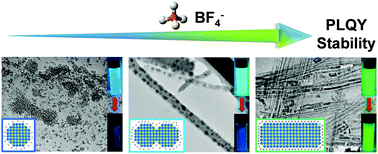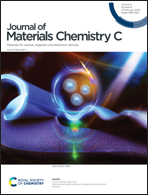In situ tetrafluoroborate-modified MAPbBr3 nanocrystals showing high photoluminescence, stability and self-assembly behavior†
Abstract
In this work, we present a facile and effective protocol, the in situ tetrafluoroborate modification route, to improve the photoluminescence and stability of CH3NH3PbBr3 (MAPbBr3) nanocrystals by directly introducing tetrafluoroborate salts into the precursor solutions in the LARP process. It is found that the incorporation of tetrafluoroborate can control the optical properties and morphologies of the MAPbBr3 nanocrystals. By adjusting the amount of BF4−, the MAPbBr3 nanocrystals with tunable emission (480–525 nm) and high photoluminescence are acquired. Simultaneously, the stability of the MAPbBr3 nanocrystals can also be greatly improved via in situ tetrafluoroborate modification. More interestingly, the introduction of BF4− can induce the self-assembly crystal growth behavior of the MAPbBr3 nanocrystals, which exhibit orderly alignment and oriented self-assemblies. Such amazing results are primarily ascribed to the passivation of surface defects, the presence of a stable organic–inorganic hybrid ligand layer and formation of hydrogen bonding between BF4− and MA+ upon in situ incorporation of tetrafluoroborate.



 Please wait while we load your content...
Please wait while we load your content...